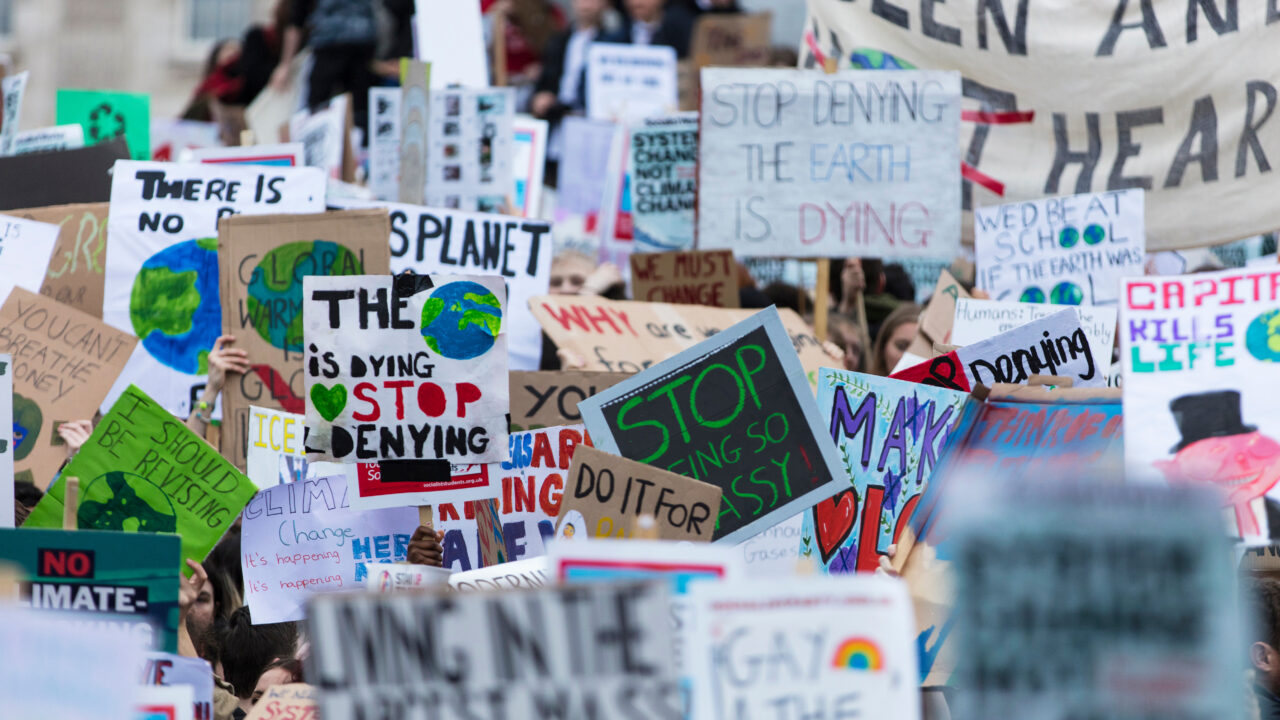Six Lessons for Climate Activists in Turbulent Times
How the climate movement can keep building power and supplying hope amid a worsening crisis. Image: Adobe
Image: Adobe
Not many eras in modern U.S. history have been as turbulent for activists as the last 18 months. Grassroots organizers have had to contend with a lingering pandemic, increasingly unstable geopolitics and signs that Earth’s ecological systems are finally paying us back for decades of abuse. For the climate movement in particular, it’s been a confusing time with unprecedented wins juxtaposed against a backdrop of worsening planetary crises.
I had the chance to reflect deeply on these realities while preparing an updated edition of “Movement Makers: How Young Activists Upended the Politics of Climate Change” — a book that distills inspirational moments and lessons from more than two decades of youth-led climate organizing in the United States. The insights and wisdom shared by the more than 100 movement leaders I interviewed for the book remain as relevant today as in 2022, when the first edition was released. At the same time, much has happened since then in the youth climate movement and the social landscape in which it operates.
From developing new approaches to kicking fossil fuels off campus to responding to extreme weather, young climate activists and their allies have shown how dynamic and creative this movement still is. Drawing from a new chapter in “Movement Makers,” here are six important lessons from the last year and a half for anyone invested in the goals of the climate movement.
1. The climate crisis is escalating
From the passage of sweeping federal legislation to the halting of major fossil fuel projects, the climate movement — particularly its youth-led contingent — has won astonishing recent victories. These couldn’t come at a more important time, as the climate crisis only continues to worsen. Last year was far and away the warmest ever recorded, with temperature spikes that took even scientists by surprise. It was also exceptional when it came to extreme weather in the U.S. and around the world.
According to U.S. government data, an estimated 65 million people experienced extreme heat last year in the United States alone. The country endured 28 weather disasters costing a billion dollars or more—the highest number in history. The inflation-adjusted average annual number of such events over the past half-decade was 18, while during the longer period from 1980-2022 it was just over eight. Extreme weather in 2023 included massive floods in California, Kentucky and New York; extreme thunderstorms in Alaska; drought on the Great Plains; and the country’s most damaging wildfire in over a hundred years on the island of Maui.
“The flames may fade from the headlines, but the journey to rebuild will be long and challenging,” the youth-led Sunrise Movement said in an email to supporters shortly after the Maui disaster. While limiting carbon emissions to prevent climate catastrophes from getting even worse is still an overwhelmingly urgent goal, so is the need to respond with support and compassion for survivors of extreme weather tragedies. Striking this balance has become an increasingly urgent priority for Sunrise and other groups.
2. The clean economy is booming
As climate-related disasters worsen, other, more hopeful trends show the climate movement has given the world at least a fighting chance at averting the worst future scenarios. In the U.S., the last 18 months provided an opportunity to judge the effectiveness of the first major federal climate legislation in the country’s history. Climate components of the Inflation Reduction Act, or IRA, signed into law by President Biden in July 2022 are far from perfect. However, within the context of the long struggle to pass any wide-reaching U.S. climate law, its importance can’t be overstated.
The IRA may have been crafted by senators making backroom deals on Capitol Hill — but there can be hardly any doubt the law never would have come into being without grassroots political pressure from the climate movement. And, excitingly, it now appears these activists’ work is having a bigger impact than even the IRA’s architects dared hope.
Before the IRA’s passage, the Congressional Budget Office projected it would lead to $369 billion in federal spending on clean technologies. However, this was just an educated guess, and it remained to be seen how much companies and investors would really take advantage of the tax incentives at the core of the IRA’s climate provisions. A year and a half later, it seems clear the actual amount of funds channeled into clean energy will be far more than the CBO estimate.
Within a year of the IRA’s passage, developers in the U.S. announced over 270 new clean energy projects and green technology manufacturing facilities, with potential to create 170,000 jobs. By April 2023, Goldman Sachs was estimating total federal investments under the law will reach $1.2 trillion by 2032, while triggering up to $3 trillion in additional private sector spending. The climate movement’s dream of a surge in clean energy that generates jobs and bolsters the middle class seems to be within reach.
3. Mass protests are getting things done
Young climate activists found creative ways to campaign through the height of the pandemic, harnessing Zoom and social media to organize during lockdowns, school closures and restrictions on large gatherings. Still, by the time the country emerged from the worst of the public health emergency, it had taken a toll on efforts to mobilize huge numbers of people in visible ways that show the depth of public support for climate action. Fortunately, it appears the climate movement is recovering its ability to organize mass protests.
In September, 75,000 people rallied in New York for the March to End Fossil Fuels, the largest post-COVID climate protest in the U.S. so far. It was impressive proof that the movement can still bring tens of thousands of people into the streets — and other large mobilizations are now in the works. Earlier this month, Bill McKibben, Sunrise Movement founder Varshini Prakash, youth climate strike leader Alexandria Villaseñor, and other prominent activists announced plans for a mass civil disobedience from Feb. 6-8 in Washington, D.C. to protest the CP2 liquefied natural gas export project proposed for construction in Louisiana.
Just the prospect of such a widely publicized protest seems to have helped convince the Biden administration to pause its review of CP2 and other LNG terminals so their climate impacts can be considered. In the wake of this major victory, the sit-in has been called off, but the fact that the mere threat of large-scale nonviolent civil disobedience had such an impact shows the effectiveness of mass mobilizations.
4. We’re winning in court
Last August, a judge in Montana issued perhaps the most important ruling yet in the ongoing effort to use litigation to hold U.S. policymakers accountable for failing to protect young people from climate change. In Held v. Montana, District Judge Kathy Seeley decided in favor of 16 young plaintiffs who argued the State of Montana violated their rights by passing a law essentially banning climate from being considered during the permitting of large energy projects.
A broad coalition of groups brought Montanans out to rally in support of the Held plaintiffs, demonstrating how courtroom battles can help galvanize a larger movement. Judge Seeley’s final verdict made headlines around the world — and the media attention it received is a powerful reminder that court rulings shape not only the enforcement of laws, but the public narrative about the moral stakes involved in an issue like climate policy.
There are aspects of the Held case that make it somewhat unique. A clause in Montana’s state constitution guarantees residents the right to a “clean and healthful environment,” and these words provided the main rationale for Judge Seeley’s ruling. The U.S. Constitution has no similar provision, and the list of states with comparable constitutional clauses — including Pennsylvania, Rhode Island, Hawaii and New York — is relatively short. However, a growing grassroots movement seeks to add “green amendments” to the constitutions of other states, and Held is likely to further energize these efforts. This means the case could have a real legal impact far beyond Montana.
5. Fossil fuels are under siege on campus
The history of climate organizing on U.S. college campuses can be roughly divided into three phases. From the early 2000s through about 2012, student activists tended to focus on greening campus operations. The architects of early campaigns like the Campus Climate Challenge knew these efforts could train a new generation of organizers, and wisely framed their work as part of a larger push to transform the economy. However, while sweeping change was the goal, in the short term most campus groups focused on smaller-scale energy efficiency or renewables projects. This began to change with the birth of the fossil fuel divestment movement at Swarthmore College.
Divestment organizers reframed the climate fight as a confrontation with the fossil fuel industry itself, and universities led a wave of institutions that by the end of last year had divested over $40 trillion from coal, oil and gas companies. Still, like any successful social movement, youth climate activists had to keep finding new ways to push the political envelope forward. Groups like Sunrise Movement and Zero Hour effectively channeled students’ energy into national climate politics, swaying national elections and eventually securing passage of the IRA. Meanwhile, the campus-based wing of the movement broadened its focus, applying the original logic of fossil fuel divestment to other areas of life at higher education institutions.
When the first edition of “Movement Makers” came out, this shift was just getting started — and it’s fascinating to reflect on how it has evolved since. Students are calling on academic research departments to refuse money from the fossil fuel industry, winning victories at schools like Princeton. At the University of Washington, student activists held a sit-in at the college career center to protest fossil fuel companies recruiting on campus. Meanwhile, efforts to decarbonize campus have graduated from small-scale projects to pushing universities to eliminate their use of gas or other fossil fuels for heat and electricity.
“The divestment movement has accomplished really positive things,” said Phoebe Barr, a Harvard student who worked on the successful Divest Harvard campaign and more recently joined a Fossil Free Research sit-in at the Ivy League school. “Now that we’ve won on divestment and shown the kind of impact climate activism on campus has, I’m excited to move into this new realm.”
6. Hope encourages action
Being a climate activist today means navigating the tension between two seemingly disparate realities. On one hand, a clean energy future feels nearer than ever; and yet, the climate crisis is still getting worse. As floods, droughts and wildfires overwhelm much of the world, it can be easy to lose hope. However, youth climate activists have proven grassroots organizing makes a real difference. It’s imperative we continue driving momentum forward at this time when real solutions are close to within reach.
Last fall, I taught a course at Western Washington University called Hope and Agency in a Climate-Altered World. The students, mostly freshmen, were far more knowledgeable about climate change and its implications than I was at their age — but their sense of dread about what’s to come in a world of worsening disasters was palpable.
As we discussed grassroots campaigns like Sunrise Movement, fossil fuel divestment, and other efforts to oppose the fossil fuel industry, I saw many students become newly hopeful that all may not be lost. This left me even more convinced of the importance of learning about the climate movement’s past. Once you understand how young people and their allies have upended politics before, it becomes clear we can do so again. That’s why I wrote “Movement Makers” in the first place, and why releasing the new edition feels timely.
If I’ve learned anything from studying more than two decades of climate movement history, it’s the power of grassroots organizing to transform the course of events — even in a fight against some of the most powerful industries on the planet. The youth climate movement is as capable and resilient as ever, and I can’t wait to see what it accomplishes next.
Your support matters…Independent journalism is under threat and overshadowed by heavily funded mainstream media.
You can help level the playing field. Become a member.
Your tax-deductible contribution keeps us digging beneath the headlines to give you thought-provoking, investigative reporting and analysis that unearths what's really happening- without compromise.
Give today to support our courageous, independent journalists.








You need to be a supporter to comment.
There are currently no responses to this article.
Be the first to respond.